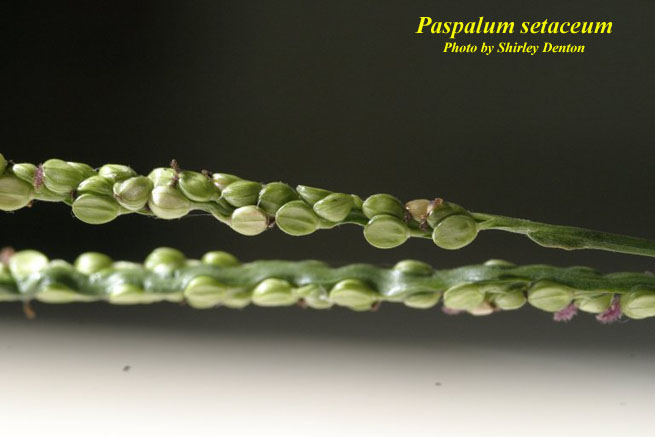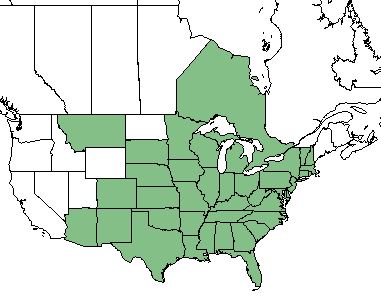Difference between revisions of "Paspalum setaceum"
(→Distribution) |
(→Ecology) |
||
| Line 30: | Line 30: | ||
==Ecology== | ==Ecology== | ||
| − | ===Habitat=== | + | ===Habitat=== |
| − | + | Habitats include, sandhills, savannas, and other dry soils. Other varieties can be found in grasslands, pine flatwoods, pince savannas, old fields, and other fields. <ref name= "Weakley"> Weakley, A. S. (2015). Flora of the Southern and Mid-Atlantic States. Chapel Hill, NC, University of North Carolina Herbarium.</ref> | |
| + | ===Phenology=== | ||
| + | Flowering has been recorded for ''P. setaceum'' in June. <ref name= "Pan Flora"> [http://www.gilnelson.com/PanFlora/ Pan Flora]</ref> | ||
<!--===Seed dispersal===--> | <!--===Seed dispersal===--> | ||
<!--===Seed bank and germination===--> | <!--===Seed bank and germination===--> | ||
| − | <!--===Fire ecology=== | + | <!--===Fire ecology===--> |
<!--===Pollination===--> | <!--===Pollination===--> | ||
| − | + | ===Use by animals=== | |
| + | ''P. setaceum'' provides forage for livestock and deer in Texas. <ref name= "USDA"> [https://plants.usda.gov/core/profile?symbol=CEAM USDA Plant Database]</ref> | ||
| + | |||
| + | Birds will eat the seeds.<ref name= "USDA"> [https://plants.usda.gov/core/profile?symbol=CEAM USDA Plant Database]</ref> | ||
<!--==Diseases and parasites==--> | <!--==Diseases and parasites==--> | ||
Revision as of 17:46, 24 May 2018
| Paspalum setaceum | |
|---|---|

| |
| Photo by Shirley Denton hosted at Atlas of Florida Plants | |
| Scientific classification | |
| Kingdom: | Plantae |
| Division: | Magnoliophyta - Flowering plants |
| Class: | Liliopsida - Moncots |
| Order: | Poales |
| Family: | Poaceae |
| Genus: | Paspalum |
| Species: | P. setaceum |
| Binomial name | |
| Paspalum setaceum Michx. | |

| |
| Natural range of Paspalum setaceum from USDA NRCS Plants Database. | |
Contents
Taxonomic Notes
Synonym: P. debile (Michaux)
Varieties: Paspalum setaceum var. ciliatifolium (Michaux), Paspalum setaceum var. longepedunculatum (LeConte), Paspalum setaceum var. muhlengergii (Nash), Paspalum setaceum var. psammophilum (Nash), Paspalum setaceum var. rigidifolium (Nash), Paspalum setaceum var. stramineum (Nash), Paspalum setaceum var. supinum (Bosc ex Poiret), Paspalum setaceum var. villosissimum (Nash)
Description
P. setaceum is a perennial graminoind of the Poaceeae family that is native to North America. [1]
Distribution
P. setaceum is found throughout the majority of the continental United States, excepting western states North Dakota, Wyoming, Utah, Nevada, Idaho, Washington, Oregon, and California. It is also found in Ontario, Canada. [1]
Ecology
Habitat
Habitats include, sandhills, savannas, and other dry soils. Other varieties can be found in grasslands, pine flatwoods, pince savannas, old fields, and other fields. [2]
Phenology
Flowering has been recorded for P. setaceum in June. [3]
Use by animals
P. setaceum provides forage for livestock and deer in Texas. [1]
Birds will eat the seeds.[1]